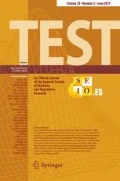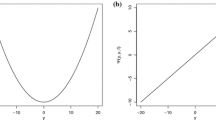Abstract
For stationary time series of nominal categorical data or ordinal categorical data (with arbitrary ordered numberings of the categories), autocorrelation does not make much sense. Biswas and Guha (J Stat Plan Infer 139:3076–3087, 2009a) used mutual information as a measure of association and introduced the concept of auto-mutual information in this context. In this present paper, we introduce general auto-association measures for this purpose and study several special cases. Theoretical properties and simulation results are given along with two illustrative real data examples.


Similar content being viewed by others
References
Agresti A (2013) Categorical data analysis, 3rd edn. Wiley, New York
Ali SM, Silvey SD (1966) A general class of coefficients of divergence of one distribution from another. J Royal Stat Soc B 28:131–142
Bagnato L, Punzo A, Nicolis O (2012) The autodependogram: a graphical device to investigate serial dependences. J Time Series Anal 33:233–254
Bishop YMM, Fienberg SE, Holland PW (1975) Discrete multivariate analysis: theory and practice. MIT Press, Cambridge
Biswas A, Guha A (2009a) Time series analysis of categorical data using auto-mutual information. J Stat Plan Infer 139:3076–3087
Biswas A, Guha A (2009b) Time Series of categorical data using auto-mutual information with application of fitting an AR (2) model. Adv Mult Stat Method 4:421
Biswas A, Song PXK (2009) Discrete-valued ARMA processes. Stat Probab Lett 79:1884–1889
Box GEP, Jenkins GM (1970) Time series analysis forecasting and control. Holden-Day, San Francisco
Cover T, Thomas J (1991) Elements of information theory. Wiley, New York
Cressie N, Read TRC (1984) Multinomial goodness-of-fit tests. J Roy Stat Soc B 46:440–464
Csiszár I (1963) Eine Informationtheorestiche Ungleichung und ihre Anwendung anf den Beweis der Ergodizitt Markoffshen Ketten. Publ Math Inst Hungarian Acad Sci A 8:84–108
Fernandes M, Néri B (2009) Nonparametric entropy-based tests of independence between stochastic processes. Economet Rev 29:276–306
Goodman LA, Kruskal WH (1954) Measures of association for cross classifications: part I. J Am Stat Assoc 49:732–764
Guha A (2005) Analysis of dependence structures of hybrid stochastic processes using mutual information. Dissertation, University of California, Berkeley.
Havrda J, Charvát F (1967) Quantification method of classification processes. Concept of structural \(\alpha \)-entropy. Kybernetika 3:30–35
Hurvich CM, Tsai CL (1989) Regression and time series model selection in small samples. Biometrika 76:297–307
Jacobs PA, Lewis PAW (1978a) Discrete time series generated by mixtures I: correlational and runs properties. J Roy Stat Soc B 40:94–105
Jacobs PA, Lewis PAW (1978b) Discrete time series generated by mixtures II: asymptotic properties. J Roy Stat Soc B 40:222–228
Jacobs PA, Lewis PAW (1978) Discrete time series generated by mixtures III: autoregressive processes (DAR(p)). Naval Postgrad Sch Tech. Report NPS55-78-022
Jacobs PA, Lewis PAW (1983) Stationary discrete autoregressive-moving average time series generated by mixtures. J Time Series Anal 4:19–36
Kullback S (1985) Kullback information. In: Kotz S, Johnson NL (eds) Encyclopaedia of statistical sciences, vol 4. Wiley, New York, pp 421–425
Latour A (1998) Existence and stochastic structure of a non-negative integer-valued autoregressive process. J Time Series Anal 19:439–455
Maiti R, Biswas A, Guha A, Ong SH (2013) Modelling and coherent forecasting of zero-inflated time series count data. Stat Model, To appear
Pardo JA, Pardo L, Pardo MC (2006a) Minimum \(\Phi \)-divergence estimator in logistic regression models. Stat Pap 47:91–108
Pardo JA, Pardo L, Pardo MC (2006b) Testing in logistic regression models based on \(\Phi \)-divergence measures. J Stat Plan Infer 136:982–1006
Pegram GGS (1975) A multinomial model for transition probability matrices. J Appl Probab 12:498–506
Pegram GGS (1980) An autoregressive model for multilag Markov chains. J Appl Probab 17:350–362
Raftery AE (1985) A model for high-order Markov chains. J Roy Stat Soc B 47:528–539
Stoffer DS (1985) Central limit theorems for finite Walsh–Fourier transforms of weakly stationary time series. J Time Series Anal 6:261–267
Stoffer DS (1987) Walsh–Fourier analysis of discrete-valued time series. J Time Series Anal 8:449–467
Stoffer DS, Scher MS, Richardson GA, Day NL, Coble PA (1988) A Walsh–Fourier analysis of the effects of moderate maternal alcohol consumption on neonatal sleep-state cycling. J Am Stat Assoc 83:954–963
Stoffer DS, Tyler DE, Wendt DA (2000) The spectral envelope and its applications. Stat Sci 15:224–253
Vajda I (1989) Theory of statistical inference and information. Kluwer Academic Publishers, Dordrecht
Weiß CH (2011) Empirical measures of signed serial dependence in categorical time series. J Stat Comput Sim 81:411–429
Weiß CH (2013) Serial dependence of NDARMA processes. Comput Stat Data Anal 68:213–238
Weiß CH, Göb R (2008) Measuring serial dependence in categorical time series. Adv Stat Anal 92:71–89
Acknowledgments
We thank three anonymous referees for their many helpful comments and for pointing us to several important references which have lead to significant improvement in the paper.
Author information
Authors and Affiliations
Corresponding author
Rights and permissions
About this article
Cite this article
Biswas, A., del Carmen Pardo, M. & Guha, A. Auto-association measures for stationary time series of categorical data. TEST 23, 487–514 (2014). https://doi.org/10.1007/s11749-014-0364-8
Received:
Accepted:
Published:
Issue Date:
DOI: https://doi.org/10.1007/s11749-014-0364-8




